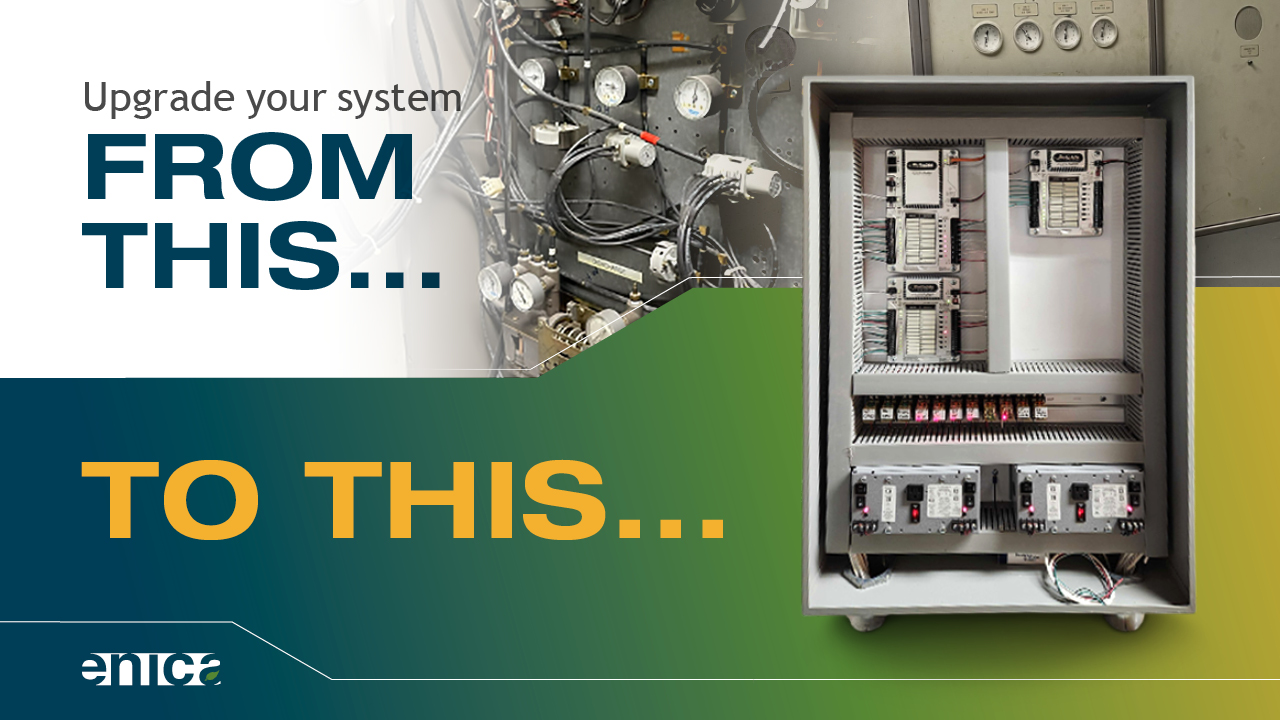Bring Your Pneumatic System Out of the Dark by Upgrading to Direct Digital Control (DDC)
Recently, a facilities operator told us that they were “in the dark” when it came to their aging pneumatic control systems because they didn’t have the visibility and controllability of modern Direct Digital Control (DDC) BMS systems. Concerns around operational reliability and impending LL97 fines moved this project up their priority list.
Recent AHU Upgrade Project
Enica recently completed a pneumatic-to-DDC upgrade on 3 AHUs collectively totaling approximately 40,000 CFM. The project resulted in a 140 tCO2e carbon footprint reduction and $36,000 in annual energy savings. Through Enica’s market partnership with ConEd, we were able to get ~40% cost coverage in incentive funding to offset project costs.
Enica’s vendor-agnostic BMS project delivery method enabled the team to deliver this project across 3 AHUs on a streamlined 12-week schedule, with little to no equipment downtime and an imperceptible impact on the spaces and occupants.
Upon completion, the project gave the operations team a modern DDC BMS with all the features and benefits of graphical interfaces, alarming, and trending capabilities. It allowed the team to leverage modern control strategies, such as temperature resets and setbacks, resulting in a meaningful carbon footprint reduction and impactful annual energy cost savings. With nearly half the project costs covered by utility incentives, the ROI and project economics were workable within existing owner budget constraints.
HVAC Pneumatic-to-DDC Upgrades: Partial vs. Full
HVAC pneumatic-to-DDC upgrade projects can come in two forms: partial and full.
A partial upgrade requires that some of the existing pneumatics remain. This upgrade typically uses electric-to-pneumatic transducers, also known as I/Ps or E/Ps. In this approach, a new DDC controller is installed, replacing the pneumatic control panel.
The new DDC controller sends electrical signals to transducers that convert the electrical signals to pneumatic control pressure for device control. This conversion is achieved by using a solenoid valve or a similar device that regulates control air.
Typical partial upgrades involve the following:
- New DDC controller with new electric-to-pneumatic transducers to replace older pneumatic control panels.
- Existing pneumatic tubing and pneumatic control devices, such as valve actuators, remain.
- New DDC sensors, such as temperature and relative humidity sensors, replace older pneumatic sensors.
A full upgrade replaces all the existing pneumatic controls and devices with new electronic equipment. This involves new sensors and actuators for the physical components, such dampers and valves.
The engineering team must be diligent when determining whether the physical components are compatible with the new actuators or if the physical components need to be replaced as well. For example, can the existing valve remain with a new DDC actuator or does the whole valve and actuator assembly need to be replaced?
Generally, Enica leans towards recommending a full upgrade to replace all pneumatic devices and pneumatic components at once. This comes with a notable first cost increase and often requires more than just a controls contractor to implement, since piping and sheet metal work is required to replace valves and dampers if the pneumatic actuators can’t be retrofitted.
But replacing dampers and adding new air flow stations often affords the opportunity to deploy better demand control ventilation strategies, saving more energy and improving project economics.
There are several considerations, including age of equipment, access, serviceability, quantities, and first costs, that must be evaluated when deciding between a full or partial upgrade. Generally speaking, broader BMS considerations beyond a pneumatic upgrade project can have a significant impact on operational reliability and energy savings for any project.
The Benefits of Pneumatic-to-DDC Upgrades
Upgrading your building’s HVAC system from a pneumatic control system to a Direct Digital Control (DDC) system can offer several benefits. According to the ASHRAE Handbook: HVAC Systems and Equipment, upgrading a pneumatic control system to a DDC system can improve energy efficiency, reduce maintenance costs, and enhance occupant comfort.
Upgrading also gives operators and facilities mangers better visibility via modern graphical user interfaces. DDC systems allow for more precise control of HVAC equipment, resulting in reduced energy usage and improved comfort. Additionally, the digital system reduces the need for mechanical components that can wear out over time, reducing maintenance costs and increasing the overall reliability of the system.
Proper design, installation, and commissioning of DDC systems is essential to ensure their optimal performance and energy efficiency.
Upgrading your building’s HVAC system from a pneumatic control system to a DDC system can offer several benefits, including:
- Energy savings: A DDC system can help optimize the performance of your building’s HVAC equipment, resulting in energy savings. The system can automatically adjust heating, cooling, and ventilation based on occupancy and outdoor temperature, reducing unnecessary energy usage.
- Improved occupant comfort: With a DDC system, you can achieve better control over your building’s temperature and humidity levels, ensuring greater occupant comfort.
- Increased reliability: Pneumatic systems rely on mechanical components that can wear out over time, leading to equipment failure and costly repairs. A DDC system eliminates these components and replaces them with digital controls that are more reliable and require less maintenance.
- Enhanced monitoring and diagnostics: A DDC system allows for real-time monitoring and diagnostics of your building’s HVAC equipment, allowing you to identify and address issues before they become major problems.
- Integration with other building systems: A DDC system can be integrated with other systems in your building to create a more cohesive and efficient system.
Upgrade Your HVAC System to Start Seeing the Benefits
In summary, upgrading your building’s HVAC system from pneumatic to DDC can offer a range of benefits, including energy savings, improved occupant comfort, increased reliability, enhanced monitoring and diagnostics, and integration with other building systems.
With the potential for significant energy savings and improved comfort, a pneumatic to DDC upgrade can be a smart investment for any commercial building owner or operator.
Interested in learning more about upgrading? Reach out to our experts today to discuss your needs >>

